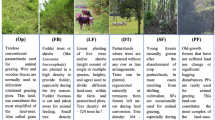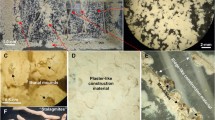Summary
We examined the role of subterranean termites in decomposition of cattle dung, various herbaceous plant species and wood in a Chihuahuan desert ecosystem. From July–September, termites removed dung at a rate of 0.63 g day-1 accounting for a percent mass loss of 19.5–100%. During the autumn subterranean termites consumed more than 50% of the leaves of the shrub Larrea tridentata, the grass Erioneuron pulchellum and annual plant Lepidium lasiocarpum and Baileya multiradiata but used very little of two other annuals Eriastrum diffusum and Eriogonum trichopes. Yucca inflorescence stalks on plots with termites lost 23% of their original mass in 30 months while those on termite free soils lost 11%. Elimination of termites resulted in reduction of fluff grass, Erioneuron pulchellum biomass, thereby affecting the structure of the ecosystem.
Similar content being viewed by others
References
Allen CT, Foster DE, Ueckert DN (1980) Seasonal food habits of a desert termite Gnathamitermes tubiformans, in West Texas. Environ Entomol 9:461–466
Anderson JM, Coe MJ (1974) Composition of elephant dung in an arid tropical environment. Oecologia 14:111–125
Chew RM (1974) Consumers as regulators of ecosystems: an alternative to energetics. Ohio J Sci 74:359–370
Ettershank E, Ettershank JA, Whitford WG (1980) Location of food sources by subterranean termites. Environ Entomol 9:645–648
Ferrar P, Watson JAL (1970) Termites associated with dung in Australia. J Aust Entomol Soc 9:100–102
Fowler H, Whitford WG (1980) Termites, microarthropods and the decomposition of senescent and fresh creosotebush (Larrea tridentata) leaf litter. J Arid Environ 3:63–68
Haverty MI, Nutting WL (1974) Natural wood-consumption rates and survival of a dry-wood and a subterranean termite at constant temperatures. Ann Entomol Soc Amer 67:153–157
Haverty MI, Nutting WL (1975a) A simulation of wood consumption by the subterranean termite Heterotermes aureus (Snyder) in an Arizona desert grassland. Insectes Sociaux 22:93–102
Haverty MI, Nutting WL (1975b) Density, dispersion and composition of desert termite foraging populations and their relationship to superficial dead wood. Environ Entomol 4:480–486
Johnson KA, Whitford WG (1975) Foraging ecology and relative importance of subterranean termites in Chihuahuan desert ecosystems. Environ Entomol 4:66–70
Parker LW, Fowler HG, Ettershank G, Whitford WG (1982) The effects of subterranean termite removal on desert soil nitrogen and ephemeral flora. J Arid Environ 5:53–59
Santos PF, DePree E, Whitford WG (1978) Spatial distribution of litter and microarthropods in a Chihuahuan desert ecosystem. J Arid Environ 1:41–48
Schaefer DA, Whitford WG (1981) Nutrient cycling by the subterranean termite Gnathamitermes tubiformans in a Chihuahuan desert ecosystem. Oecologia 48:277–283
Valiela I (1974) Composition, food webs and population limitation in dung arthropod communities during invasion and succession. Amer Midl Natur 92:370–385
Whitford WG (1973) Jornada Validation Site Report US/IBP 73-4 Utah State University, Logan, Utah, pp 1–32
Wood TG (1976) The role of termites (Isoptera) in decomposition processes. In The role of terrestrial and aquatic organisms in decomposition processes, Anderson (JM) and MacFadyen, (A), Blackwell Scientific Publications, London, 145–161
Wood TG (1978) Food and feeding habits of termites. In Production ecology of ants and termites, Brian (MV), Cambridge University Press, Cambridge, 55–80
Author information
Authors and Affiliations
Rights and permissions
About this article
Cite this article
Whitford, W.G., Steinberger, Y. & Ettershank, G. Contributions of subterranean termites to the “economy” of Chihuahuan desert ecosystems. Oecologia 55, 298–302 (1982). https://doi.org/10.1007/BF00376915
Received:
Issue Date:
DOI: https://doi.org/10.1007/BF00376915




